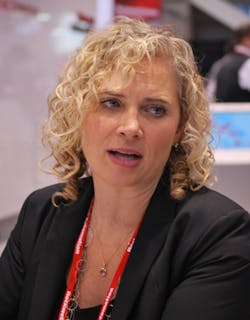Implementation latest step in Connected Enterprise evolution
Have you heard about this Industrial Internet of Things thing? Whether you’ve heard it called smart manufacturing, Industry 4.0, China 2025 or any number of other names, it’s all about connecting and sharing information that drives business value. It’s about connecting the enterprise, so that data becomes information, which begets business intelligence in the form of knowledge and wisdom.
Rockwell Automation calls it The Connected Enterprise: enabling an organization to turn data into value that has a positive impact on plant performance and organizational profitability. As the concept has crystallized over the past several years, the vision has become reality for a growing number of industrial concerns. So many that Rockwell Automation customers were showcased as working examples of The Connected Enterprise in a central pavilion at its Automation Fair event this week in Chicago.
“We’ve been talking about The Connected Enterprise for several years now,” explained Beth Parkinson, market development director, The Connected Enterprise, Rockwell Automation. “The concept sounds great. But what does it mean? This year, we wanted to make it more tangible and bring it to life.”
3 areas to optimize
The Connected Enterprise pavilion was designed to help customers to understand what it is and how it works in actual manufacturing environments, focusing on optimizing efficiency, visibility and collaboration.
“We’ve identified different areas where companies can start, but they don’t have to be linear.” Rockwell Automation’s Beth Parkinson explained how industrial organizations can start their own journey to becoming a Connected Enterprise.
“First, it enables efficiency across multiple production facilities by looking at capacity,” explained Parkinson. “Do you have ability to know if you can take an order and get the order to market in time? Can you look across your global enterprise and find manufacturing capacity where and when you need it? With The Connected Enterprise, you can look into those operations and make those decisions.”
Visibility impacts serialization and traceability, with a primary focus on affecting the recall dynamic. “Recalls can be costly and impact brand equity,” said Parkinson. “How can you track materials through the process? If you find a problem during the process, how do you minimize the amount of product you have to scrap? Even if it goes to market, you can shrink the amount that must be recalled.”
Collaboration is the smart-machine dynamic, because things inevitably go wrong with machines. “If some condition is trending, an operator might not be able to see it or hear it,” explained Parkinson. “If a bearing fails, the equipment can stop, which means that production stops. How do you avoid unplanned downtime? Maybe, by monitoring, you noticed that the machine is slowing down or speeding up. Maybe the machine can send a specific alert that says it’s going to need maintenance.”
One of the major benefits of the smart-machine dynamic is enabling the manufacture of products that better serve customers’ needs, by customizing to demand in real time, but also by using that data to improve product design and development. That type of information comes from the end of the manufacturing process, and obtaining that data can still be a bit of a hurdle.
“A lot of end users don’t want to give their machine suppliers access in real time,” explained Parkinson. “We’ve been talking about secure reference architectures for remote monitoring that we’ve developed with Cisco and Panduit. But, right now, people still see roadblocks. There’s still that reality of where people are coming from today. For security, we’ve put together ways to operationalize The Connected Enterprise. We’ve identified different areas where companies can start, but they don’t have to be linear. Unscheduled downtime and security issues are risk areas, but what about looking at opportunities?”
4 steps to connectivity
Making The Connected Enterprise real requires a plan, and Parkinson offered some guidance on how to get started. “First, assess where you are,” she suggested. “What’s your automation footprint? What does your security look like?”
The second step is to inventory devices, equipment and systems and identify what needs to be modernized or upgraded to take operations through the next 10 years. “Your competition will look very different in the future, and plants can no longer expect to run the same systems for 20 years.” Increasingly though, system software can be upgraded along the way to bring new features and functionality.
Next, look at your data. “Our customers collect thousands of data points,” said Parkinson. “They generate and store lots of real-time data. It might be beneficial. Sometimes, they don’t even know. We look at what data is accessible and what’s working. That’s a base stage, which can lead to an electronic batch record (EBR) system, for example.”
Finally, there’s optimization and collaboration. “You’re always trying to improve,” said Parkinson. “You’re never done. How are you collaborating within your facility? What about outside your facility? With your OEMs? With your suppliers? You might be able to get started with a use case of something you have a problem with.”
People who need people
The exodus of older, experienced workers has intensified the problem that many manufacturers already have with staffing. “The people dynamic—having available, skilled people—is a real challenge. Many people are worried that automation and robotics will take away jobs, but the truth is we can’t fill a lot of the jobs that already exist.”
The Connected Enterprise allows for the collection and contextualization of worker expertise. The tribal knowledge of a retiring worker needs to be captured, so a manufacturer can replace that individual’s ability to hear the equipment go “thunk” and know what’s going to happen and how to correct it before a failure results in production downtime.
About the Author
Mike Bacidore
chief editor

Leaders relevant to this article:



